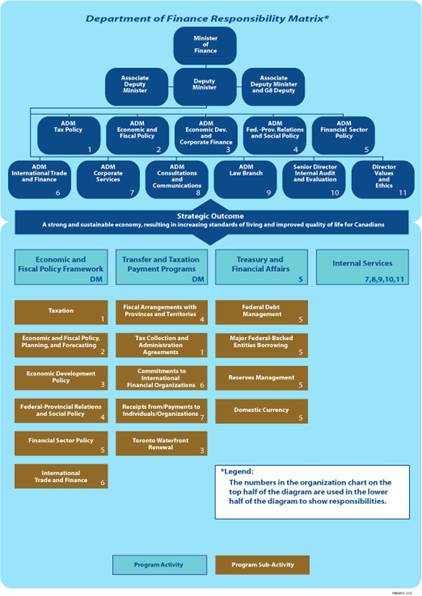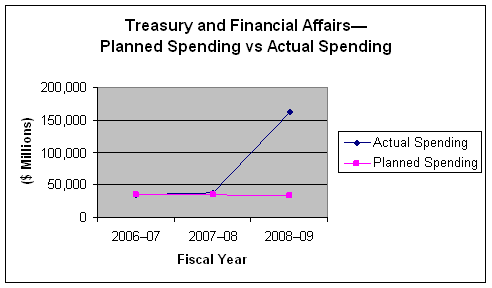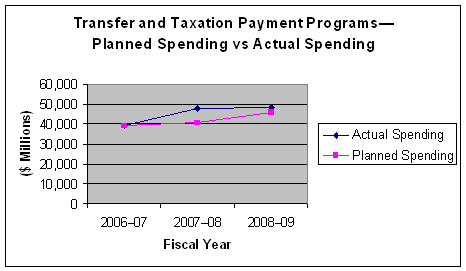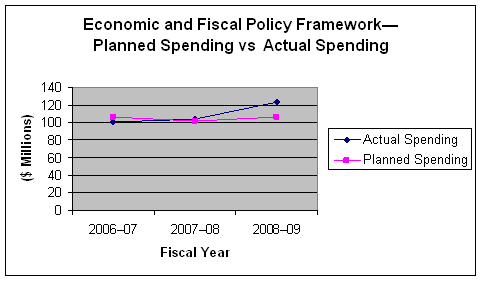Common menu bar links
Breadcrumb Trail
ARCHIVED - Department of Finance Canada
 This page has been archived.
This page has been archived.
Archived Content
Information identified as archived on the Web is for reference, research or recordkeeping purposes. It has not been altered or updated after the date of archiving. Web pages that are archived on the Web are not subject to the Government of Canada Web Standards. As per the Communications Policy of the Government of Canada, you can request alternate formats on the "Contact Us" page.
Minister's Message

The 2008–09 Departmental Performance Report highlights the Department of Finance Canada's important work over the past year to address the many challenges posed by the global economic crisis.
In particular, in 2008–09 the Department worked to develop and implement Canada's Economic Action Plan: Budget 2009 to provide necessary, timely, and comprehensive economic stimulus to weather the global recession and emerge with an even stronger economy. In fact, the International Monetary Fund (IMF) has recently praised our Action Plan as being "appropriately large, timely, well diversified and structured for maximum effectiveness."
Canada's Economic Action Plan is a vast set of initiatives, which are being implemented in record time. These measures provide a needed boost to the economy and employment today and also represent an investment in our future. The Plan does the following:
- reduces taxes permanently;
- helps the unemployed through enhanced Employment Insurance and training programs;
- avoids layoffs by enhancing the Employment Insurance work-sharing program;
- creates jobs through a massive injection of infrastructure spending;
- helps create the economy of tomorrow by improving infrastructure at colleges and universities and supporting research and technology;
- supports industries and communities most affected by the global downturn; and
- improves access to and the affordability of financing for Canadian households and businesses.
Through the Economic Action Plan, the Government of Canada is working to strengthen our economic fundamentals and ensure that this country emerges from the current recession with an even stronger economy to the benefit of all Canadians.
Section I: Departmental Overview
Raison d'�tre
The Department is committed to making a difference for Canadians by helping the Government of Canada develop and implement strong and sustainable economic, fiscal, tax, social, security, international, and financial-sector policies and programs. It plays an important role in ensuring that government spending is focussed on results and delivers value for taxpayer dollars. The Department interacts extensively with other federal departments and agencies and plays a pivotal role in the analysis and design of public policy across a wide range of issues affecting Canadians.
Responsibilities
The Department of Finance Canada's responsibilities include the following:
- preparing the federal budget;
- developing tax and tariff policy and legislation;
- managing federal borrowing on financial markets;
- administering major transfers of federal funds to the provinces and territories;
- developing regulatory policy for the country's financial sector; and
- representing Canada within international financial institutions and groups.
The Department also plays an important role as a central agency working with other departments to ensure that the government's agenda is carried out and that ministers are supported with first-rate analysis and advice.
Strategic Outcome and Program Activity Architecture
The Department of Finance Canada provides effective economic leadership with a clear focus on one strategic outcome:
A strong and sustainable economy, resulting in increasing standards of living and improved quality of life for Canadians.
In 2007, the Department revised its strategic outcome and program activity architecture (PAA) to better reflect focussed departmental efforts to improve the well-being of all Canadians. This revision positioned the Department to be better able to report to Parliament on its priorities and strategic directions.
The revised strategic outcome and PAA were fully reflected for the first time in the Department's 2008–09 Report on Plans and Priorities (RPP). A crosswalk comparing the planned spending of the earlier 2007–08 PAA with the new 2008–09 structure was presented in the 2008–09 RPP.[1]
The current PAA structure is illustrated in the figure below, which includes details on which parts of the Department are responsible for each activity area.[2]

Performance Summary
| Planned Spending | Total Authorities | Actual Spending[3] |
|---|---|---|
| 79,959.6 | 210,969.1 | 210,800.0 |
| Planned | Actual | Difference |
|---|---|---|
| 835 | 836 | -1 |
| Performance Indicators | Targets | 2008-09 Performance |
|---|---|---|
| Canada's medium-term fiscal framework | Annual debt reduction of
$3 billion Keep program spending growth below economic growth on average A declining debt-to-GDP ratio |
Since the 2008–09 RPP, the economic environment has changed dramatically. As a consequence, the targets originally made for the period were revised, and the focus is now on implementing the Government of Canada's Budget 2009. |
| Competitiveness and fairness of Canada's tax system | Tax system that raises the required revenue in a manner that compares favourably to other G7 countries |
Actions taken since 2006 will reduce taxes by $220 billion over 2008–09 and the following five fiscal years. These actions include federal corporate income tax reductions that will allow Canada to reach the goal of the lowest overall tax rate on new business investment (marginal effective tax rate or METR) in the G7 by 2010 and to have the lowest statutory corporate income tax rate in the G7 by 2012. For a full description of further actions taken, please see "Supporting tax relief and prudent fiscal management" under PA 1.1: Economic and Fiscal Policy Framework below. |
| Soundness, efficiency, and competitiveness of Canada's financial sector | Healthy, growing financial sector that serves the needs of Canadians | The Canadian financial system has been exceptionally resilient during the ongoing financial crisis that started in August 2007. While the crisis caused a series of financial institution failures in other countries, Canadian financial institutions have remained sound and well capitalized. Nevertheless, Canada was not immune to the global crisis and departmental action was required in a number of areas to support the effective functioning of the financial system and strengthen Canada's regulatory framework. The Department also led the development of the recommendations to enhance sound regulation and transparency that served as input for the G20 Leaders Summit in London. |
| Program Activity |
2007-08 Actual Spending |
2008-09 | Alignment to Government of Canada Outcomes[4] | |||
|---|---|---|---|---|---|---|
| Main Estimates |
Planned Spending |
Total Authorities |
Actual Spending |
|||
| PA 1: Economic and Fiscal Policy Framework | 105.6 | 101.8 |
105.8 |
135.0 |
122.7 |
Strong economic growth |
| PA 2: Transfer and Taxation Payment Programs | 47,945.7 | 46,023.8 | 46,023.8 | 48,758.3 | 48,601.5 | All government outcomes |
| PA 3: Treasury and Financial Affairs | 38,328.3 |
33,830.0 |
33,830.0 | 162,075.8 | 162,075.8 | All government outcomes |
| Total | 86,379.6 | 79,955.6 | 79,959.6 | 210,969.1 | 210,800.0 | |
Contribution of Priorities to the Strategic Outcome
Operational priorities
In 2008–09, the Department of Finance Canada continued to focus on its four key ongoing priorities.
Sound fiscal management
- Status: Successfully met
In 2008–09, the Department continued to play a major role in ensuring that the government continues to manage spending responsibly, maximizes the benefits of government assets to Canadians, and takes measures to reduce the cost of government operations while maintaining their effectiveness.
The Department did the following:
- contributed to the implementation of the Government of Canada's policy priorities through the development of the Fall 2008 Economic and Fiscal Statement and Budget 2009;
- provided effective analysis of domestic and international economic activity in and the implications of heightened risks for the Canadian economy;
- provided advice on expenditures and priorities in the Strategic Review of departments and agencies within its portfolio responsibilities; and
- continued to manage Government of Canada funds in accordance with the guiding principles of transparency, regularity, liquidity, and prudence.
Sustainable economic growth
- Status: Successfully met
In 2008–09, due to the severe economic downturn, the Department worked to develop and implement the Economic Action Plan to provide necessary, timely, and comprehensive economic stimulus to weather the global recession and emerge with an even stronger economy. The Plan has been designed to get stimulus out as quickly and effectively as possible. Support included funding for industries, communities, infrastructure, human capital, innovation, and financial market governance. In addition, tax reductions introduced in the Plan will help ease financial pressure on individuals, families, and businesses and contribute to a solid foundation for future economic growth.
As the government's source of analysis and advice on economic and fiscal matters, the Department continued to help ensure that policies and programs create the conditions necessary for sustainable long-term economic growth and help the country emerge from the global economic downturn.
Sound social policy framework
- Status: Successfully met
In 2008–09, the impact of the global economic downturn, coupled with volatile resource prices, necessitated actions to ensure the long-term sustainability of the Equalization Program and continuing fairness in the Canada Health Transfer (CHT).
The Department did the following:
- continued to support social programs delivered by provinces and territories—including social assistance, social services, post-secondary education, and programs for children—by means of transfer payments to provincial and territorial governments;
- provided analysis and advice on stimulus initiatives announced in Budget 2009 and on social policy measures related to social housing, employment insurance, and labour market training;
and
- contributed to the implementation of Budget 2008 initiatives for improving the capacity and flexibility of Canada's immigration system to respond to evolving labour market needs, improving federal supports for post-secondary education, and removing the disincentives to work for low-income seniors.
Effective international influence
- Status: Successfully met
As a result of the economic crisis, global finance and trade arrangements were subject to an intensive re-evaluation. In responding to the new and significant challenges that arose during this time, the Department worked to ensure that Canada demonstrated leadership in the international response to the crisis, promoted Canada's view of the response to the crisis, and promoted Canada's financial sector as a leader in regulatory practices.
Specific examples of the Department's contributions include:
- participating in international discussions to ensure that multilateral development banks (such as the World Bank) and the IMF had sufficient capacity to respond to the global economic crisis, which resulted in a number of new Canadian financing commitments, including a US$10 billion bilateral loan to the IMF, an innovative US$4 billion temporary increase in capital resources at the Inter-American Development Bank, and a US$200 million contribution to the World Bank's Global Trade Liquidity Program;
- working closely with G7 and G20 partners to deal with the global financial crisis, including participating in all four G20 working groups formed to deal with the various aspects of the crisis and co-chairing the Working Group on Enhancing Sound Regulation and Strengthening Transparency;
- supporting the Minister of Finance and the Prime Minister at a number of extraordinary international meetings to deal with the crisis, including two Leaders' Summits;
- acting as a world leader in the G7, G20, and World Trade Organization (WTO) forums in the area of resisting protectionist pressures during the global economic downturn; and
- participating in international discussions focussed on increasing IMF surveillance quality as well as countries' willingness to coordinate their economic policies and work more effectively with the IMF and others to avoid future crises.
Management priorities
In 2008–09, the Department of Finance Canada continued its efforts on the following five previously committed to priorities.
Strengthening outreach to primary partners and clients through regular meetings, presentations, and direct contact
- Status: Met all expectations
In 2008–09, the Department worked on strengthening its outreach to primary partners and clients through regular meetings with and presentations to tax professionals, business groups, non-governmental organizations, international organizations, and not-for-profit groups and regular meetings and ongoing contact with provincial and territorial counterparts (ministers, deputy ministers, and senior officials) and Aboriginal governments. The Department also played a key role in promoting a strong multilateral system of global economic and financial governance, most importantly in supporting the Minister's participation in the G7, G8, and G20 processes.
Implementing results of the 2007 strategic review
- Status: Met all expectations
In 2007, the Department conducted an in-depth review of the funding, relevance, and performance of all its programs to ensure results and value for money from programs that are a priority for Canadians. A key outcome of the review resulted in the move to dedicated corporate services for the Department and the transfer of approximately 425 FTEs who provided shared corporate services to the Treasury Board of Canada Secretariat. This transition was fully implemented with the February 2009 signing of the related Order-in-Council. The transition has resulted in a new Corporate Services Branch that is focussed on responding to the needs of the Department and better positioned to meet stewardship and accountability requirements.
Implementing an integrated gender-based analysis framework
- Status: Met all expectations
In 2008–09, the Department continued to implement an integrated gender-based analysis (GBA) framework. The Department has a GBA champion responsible for promoting GBA, facilitating its conduct, and raising its profile. In 2008–09, to support high-quality GBA, the Department's GBA champion ensured that employees had access to GBA training and examples of good GBA, which were posted on the Department's internal website. The Department, in its capacity as a central agency, played a challenge function, requiring departments and agencies to consider all relevant factors when developing a policy or program for budget consideration, including gender issues whenever appropriate. As a developer of policy, the Department of Finance Canada performed GBA on all new spending and tax policy proposals presented to the Minister, when appropriate and when data existed.
Going forward, the Department will continue to ensure that GBA is well integrated into the development and assessment of its own policies and programs, when appropriate and when data exist, and will continue to challenge other departments and agencies to do the same.
Integrated business and human resources planning
- Status: Met all expectations
In 2008, the Department adopted a results-based integrated corporate business planning framework that encompasses priority setting, environmental scanning, risk assessment, and business planning and fully integrates financial and human resource (HR) requirements with business plans. In 2008–09, a three-year HR management plan was developed and implemented to support the government's HR priorities. The plan addresses HR management gaps—including succession planning, recruitment, retention, diversity, and official languages—and responds to employee concerns. The planning cycle for 2009–10, implemented in late 2008, was structured to result in a fully integrated corporate business plan, which would link HR planning activities with business requirements.
This integrated planning framework, coupled with the Department's risk-based audit plan, positions the Department to better report on and demonstrate accountability for results and resources to Parliament and to Canadians. It also allows the Department to more strategically integrate priority setting with performance measurement and HR planning.
Continued implementation of the enhanced requirements of the 2006 Treasury Board Policy on Internal Audit
- Status: Met all expectations
The Department continued to implement the requirements of the Federal Accountability Act. As part of this process, the Department established an independent Audit and Evaluation Committee and increased funding to implement the requirements of the Policy on Internal Audit.
Risk Analysis
As an open economy, Canada has been affected by the downturn in the global economy. The Canadian economy entered a recession during the fourth quarter of 2008. Since last fall, private-sector forecasters substantially revised down their economic projections for 2009 and 2010.
In response to these extraordinary events, Budget 2009 announced a set of stimulus measures designed to protect the economy from the immediate threat of the global downturn. The Department also took action on a number of areas to support the timely implementation of the Action Plan, ensure the effective functioning of the financial system, and implement action plans agreed to by G8 and G20 leaders.
The combined impact of the recession and the cost of the measures under the Action Plan have resulted in sizeable projected deficits for the 2009–10 fiscal year and the next three fiscal years. These were neither planned nor foreseen at the beginning of 2008. However, there are now signs that the economic situation in Canada is stabilizing, with most private sector economists expecting a return to growth in the third quarter of 2009.
In this difficult and uncertain economic context, the Department continues to closely monitor the government's fiscal position, to rapidly update fiscal projections, and to closely assess the risks and uncertainties of the fiscal outlook through the Fall 2008 Economic and Fiscal Statement, Budget 2009, and the monthly Fiscal Monitor. In March and June 2009, respectively, the Department released the first two quarterly reports on the government's actions to stimulate the Canadian economy and combat the global recession.[5]
Expenditure Profile
The Department of Finance Canada's actual spending in 2008–09 was $211 billion. The graphs below illustrate the Department's actual spending in comparison to planned spending by program activity from 2006–07 to 2008–09.

The Treasury and Financial Affairs program activity increased expenditures by $124 billion in 2008–09 primarily as a result of the government's announcement in Budget 2007 to meet all of the domestic borrowing needs of Farm Credit Canada, Business Development Bank of Canada, and the Canada Mortgage and Housing Corporation (CMHC) through direct lending in order to reduce overall borrowing and improve the liquidity of the government securities market. This includes loans of $55 billion to the CMHC for the Insured Mortgage Purchase Program as part of the efforts to maintain the availability of longer term credit in Canada in response to the global financial and economic crisis in fall 2008. The impact of this was $127 billion; this was partially offset by a $3 billion decrease in "Interest and Other Costs" as a result of a significantly reduced interest rate environment in 2008–09.
Farm Credit Canada and Business Development Bank of Canada were provided limited early access to direct lending in 2007–08 and borrowed a total amount of $4.8 billion. This largely explains the increase in departmental spending from 2006–07 to 2007–08. Before this change, these Crown corporations obtained funding directly through the capital markets under their own name.

The Transfer and Taxation Payment Programs program activity increased expenditures by less than $1 billion in 2008–09 as a result of increases in ongoing statutory vote expenditures being almost completely offset by statutory votes that were discontinued at the end of 2007–08. Expenditures in 2007–08 exceeded those in 2006–07 by $8 billion because of increased expenditures on ongoing statutory votes and the implementation of statutory votes that were in effect for 2007–08 only.

The Economic and Fiscal Policy Framework program activity increased expenditures by $20 million in 2008–09 as a result of increased expenditures on advertising as well as on advisory panels. Expenditures between 2006–07 and 2007–08 were fairly consistent.
| Vote # or Statutory Item (S) | Truncated Vote or Statutory Wording | 2006-07 Actual Spending |
2007-08 Actual Spending |
2008-09 Main Estimates |
2008-09 Actual Spending |
|---|---|---|---|---|---|
| 1 | Operating expenditures1 | 89,286 | 91,556 | 89,793 | 111,124 |
| 5 | Grants and contributions2 | 315,598 | 93,377 | 374,800 | 572,034 |
| (S) | Minister of Finance—salary and motor car allowance | 73 | 74 | 76 | 76 |
| (S) | Territorial Financing (Part I.1—Federal-Provincial Fiscal Arrangements Act) | 2,118,264 | 2,221,297 | 2,312,939 | 2,312,939 |
| (S) | Payments to International Development Association | 318,270 | 318,270 | 318,280 | 318,280 |
| (S) | Contributions to employee benefit plans | 11,761 | 12,104 | 11,910 | 11,431 |
| (S) | Purchase of Domestic Coinage3 | 135,602 | 182,736 | 147,000 | 126,368 |
| (S) | Interest and Other Costs4 | 34,108,504 | 33,212,372 | 33,683,000 | 29,939,794 |
| (S) | Statutory Subsidies (Constitution Acts, 1867–1982, and Other Statutory Authorities) | 31,821 | 31,822 | 32,000 | 31,968 |
| (S) | Fiscal Equalization (Part I—Federal-Provincial Fiscal Arrangements Act)5 | 11,535,064 | 12,924,677 | 13,619,924 | 13,462,236 |
| (S) | Canada Health Transfer (Part V.1—Federal-Provincial Fiscal Arrangements Act)6 | 20,139,876 | 21,474,272 | 22,629,304 | 22,759,015 |
| (S) | Canada Social Transfer (Part V.1—Federal-Provincial Fiscal Arrangements Act)7 | 8,500,000 | 9,590,219 | 10,557,729 | 10,567,868 |
| (S) | Youth Allowances Recovery (Federal-Provincial Fiscal Revision Act, 1964)8 | (706,788) | (943,805) | (717,374) | (332,659) |
| (S) | Alternative Payments for Standing Programs (Part VI—Federal-Provincial Fiscal Arrangements Act)9 | (3,177,016) | (2,719,889) | (3,256,839) | (2,973,912) |
| – | Items not required—Payment to Ontario (Budget Implementation Act, 2007) | 0 | 250,000 | 150,000 | 150,000 |
| (S) | Incentive for Provinces to Eliminate Taxes on Capital10 | 0 | 0 | 0 | 170,000 |
| (S) | Public Transit Capital Trust 200811 | 0 | 0 | 0 | 500,000 |
| (S) | Police Officers Recruitment Fund11 | 0 | 0 | 0 | 400,000 |
| (S) | Saskatchewan Carbon Capture and Storage Demonstration Trust11 | 0 | 0 | 0 | 240,000 |
| (S) | Payment to Saskatchewan11 | 0 | 0 | 0 | 31,204 |
| (S) | Payment to Nova Scotia for Carbon Storage11 | 0 | 0 | 0 | 5,000 |
| (S) | Payment to Nunavut11 | 0 | 0 | 0 | 705 |
| (S) | Payment pursuant to the Halifax Relief Commission Pension Continuation Act | 18 | 18 | 0 | 18 |
| (S) | Payment of liabilities previously transferred to revenue | 2,075 | 1,848 | 0 | 2,303 |
| (S) | Net Loss on Exchange12 | 120,555 | 89,177 | 0 | 121,723 |
| (S) | Payment to British Columbia13 | 0 | 30,000 | 0 | 0 |
| (S) | Payment to Yukon13 | 0 | 3,500 | 0 | 0 |
| (S) | Payment to Northwest Territories13 | 0 | 54,400 | 0 | 0 |
| (S) | Clean Air and Climate Change Trust Fund13 | 0 | 1,518,925 | 0 | 0 |
| (S) | Patient Wait Times Guarantee13 | 0 | 612,000 | 0 | 0 |
| (S) | Transitional Payments13 | 0 | 614,038 | 0 | 0 |
| (S) | Child Care Spaces13 | 0 | 250,000 | 0 | 0 |
| (S) | Human Papilloma Virus Immunization13 | 0 | 300,000 | 0 | 0 |
| (S) | Community Development Trust13 | 0 | 1,000,000 | 0 | 0 |
| (S) | Refunds of amounts credited to revenue in previous years | 0 | 36 | 0 | 0 |
| (S) | Payments to the IMF's Poverty Reduction and Growth Facility | 2,615 | 0 | 0 | 0 |
| Total budgetary | 73,545,578 | 81,213,024 | 79,952,542 | 78,527,515 | |
| L10 | In accordance with the Bretton Woods and Related Agreements Act, the issuance and payment of non-interest bearing, non-negotiable demand notes in an amount not to exceed $384,280,000 to the International Development Association14 | 318,270 | 318,280 | 0 | 384,280 |
| (S) | Payments and encashment of notes issued to the European Bank for Reconstruction and Development—Capital subscriptions | 6,498 | 4,334 | 3,075 | 2,650 |
| (S) | Advances pursuant to subsection 12(2) of the Farm Credit Act15 | 0 | 3,840,000 | 0 | 47,104,810 |
| (S) | Advances pursuant to section 19 of the Business Development Bank of Canada Act15 | 0 | 1,000,000 | 0 | 23,047,000 |
| (S) | Advances pursuant to subsection 21(1) of the Canada Mortgage and Housing Corporation Act15 | 0 | 0 | 0 | 61,729,821 |
| (S) | Advances pursuant to subsection 13(1) of the Financial Consumer Agency of Canada Act | 5,000 | 4,000 | 0 | 4,000 |
| Total non-budgetary | 329,768 | 5,166,614 | 3,075 | 132,272,561 | |
| Total Department | 73,875,346 | 86,379,638 | 79,955,617 | 210,800,076 |
1. Variance between 2008–09 Main Estimates and 2008–09 Actual Spending is attributable to funding received of $15 million for advertising, $3.8 million for the Advisory Panel on Canada's System of International Taxation and supporting Secretariat to review Canada's system of taxation, and $2.8 million to support the development of a common securities regulator to help create a Canadian advantage in global capital markets.
Variance between 2007–08 Actual Spending and 2008–09 Actual Spending is primarily attributable to increases in advertising of $10 million, Panel expenditures of $5.5 million, and salary increases of $4.5 million due to collective bargaining increases.
2. Variance between 2008–09 Main Estimates and 2008–09 Actual Spending is primarily attributable to increased funding of $234.4 million for the Payment to Nova Scotia in respect of the Crown Share Adjustment Payment regarding amounts relating to previous years up to March 31, 2008.
Variance between 2007–08 Actual Spending and 2008–09 Actual Spending is attributable to the Crown Share Adjustment Payment of $234.4 million, an increase of $100 million to the grant for Debt payments to international organizations on behalf of poor countries, arising from an accelerated payment to the World Bank and African Development Fund, and the balance being attributable to increases in the grant payments for Compensation to Canadian agencies or entities established by an Act of Parliament for reduction of debts of debtor countries.
3. Variance between 2007–08 and 2008–09 Actual Spending is attributable to lower than projected demand from financial institutions for newly minted coins.
4. Variance between 2007–08 and 2008–09 Actual Spending is attributable to a significantly lower interest rate environment in 2008–09.
5. Variance between 2007–08 and 2008–09 Actual Spending is attributable to Newfoundland and Labrador re-estimate under their Equalization formula.
6. Variance between 2007–08 and 2008–09 Actual Spending is attributable to prior year adjustments arising from the Estimates cycle as well as deductions made under the Canada Health Act.
7. Variance between 2007–08 and 2008–09 Actual Spending is attributable to prior year adjustments arising from the Estimates cycle as well as a revised estimate of 2008–09 requirements made in October 2008.
8. Variance between 2007–08 and 2008–09 Actual Spending is attributable to prior year adjustments arising from the Estimates cycle as well as a revised estimate of 2008–09 requirements made in February 2009. The $611 million reduced recovery from 2007–08 is a result of Quebec making a payment in 2007–08 toward its 2008–09 obligation as well as changes in the value of tax points used to calculate the recovery.
9. Variance between 2007–08 and 2008–09 Actual Spending is attributable to prior year adjustments arising from the Estimates cycle as well as a revised estimate of 2008–09 requirements made in February 2009.
10. Variance between 2007–08 and 2008–09 Actual Spending is attributable to the statutory vote being approved through the Budget Implementation Act, 2007.
11. Variance between 2007–08 and 2008–09 Actual Spending is attributable to the statutory vote being approved through the Budget Implementation Act, 2008.
12. Increase in losses resulting from re-evaluation of assets and liabilities denominated in foreign currencies to Canadian currencies.
13. Variance between 2007–08 and 2008–09 Actual Spending is attributable to the statutory vote being approved after the preparation of the 2008–09 Main Estimates.
14. Loan note listed in the Main Estimates as a $1 item. Authority is in note wording. Variance between 2007–08 and 2008–09 Actual Spending represents increase in the value of the next International Development Association negotiated agreement.
15. The government announced in Budget 2007 that it plans to meet all of the domestic borrowing needs of Farm Credit Canada, Business Development Bank of Canada, and the Canada Mortgage and Housing Corporation through direct lending beginning April 1, 2008.
